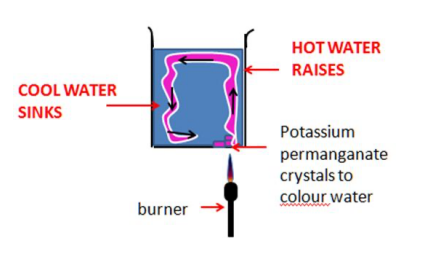Thermal Convection (GCSE Physics)
Thermal Convection
Convection
Heat is usually transferred by conduction in solids. In liquids and gasses, convection and radiation are more important.
Convection is the flow of heat through a fluid from areas of a higher temperature to areas of a lower temperature by movement of the fluid itself.
A convection current is a stream of warm moving fluid.
Convection in liquids
Convection of a liquid can be seen in an experiment using potassium permanganate.
A crystal of potassium permanganate is placed in a beaker of water and gently heated with a Bunsen flame. Heat will be transferred through the glass wall of the beaker by conduction. This heats the water near the Bunsen flame, so it becomes less dense and rises. The cold, denser air above it sinks down and is in turn heated by the Bunsen flame. The pink colour due to the potassium permanganate shows the convection current.

Convection in air
Radiators transfer heat via convection. Air near the radiator is heated, which causes it to become less dense. Therefore this warm, less dense air rises up the room, and the cold, denser air above it sinks down. The cold air can now be heated by the radiator. This cycle goes on and on, and a convection current is formed. The heat is spreading through the room via this current.

Natural Convection Currents
- Coastal breezes – during the day, the temperature of land increases at a faster rate than the sea. The hot air above the land rises and is replaced by colder air from the sea, resulting in a breeze from the sea.
- Gliding – gliders use hot air currents, known as thermals, to fly for several hours.





Still got a question? Leave a comment
Leave a comment